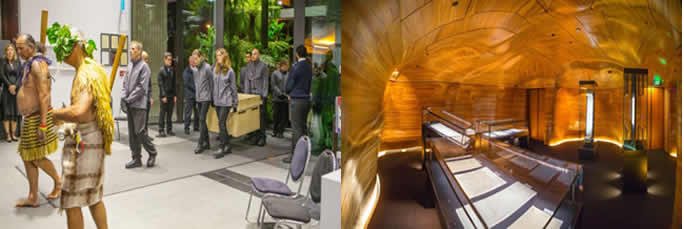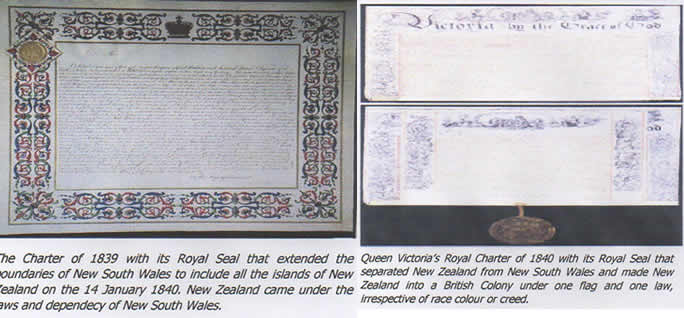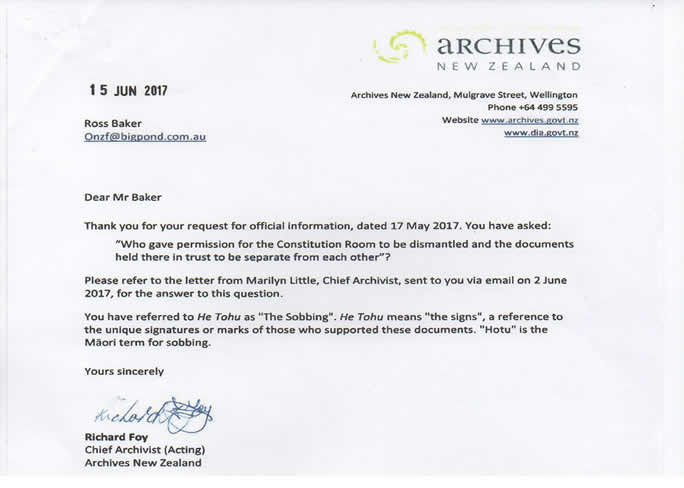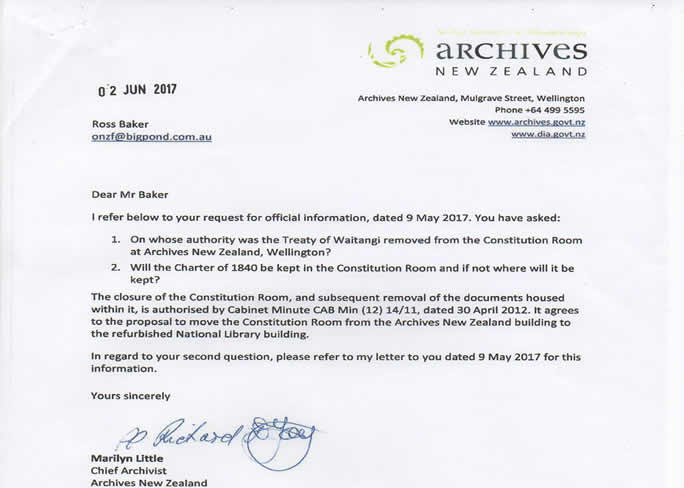He Tohu – The Lie!

“He Tohu is a new permanent exhibition of 3 iconic constitutional documents that shaped Aotearoa New Zealand”, Archives New Zealand. This is a lie!
On the 17 April 2017 the Constitution Room at Archives New Zealand was dismantled and our historic documents separated with the Declaration of Independence, the Tiriti o Waitangi and the Women’s Suffrage Petition being moved under darkness to the new taxpayer funded $7.2 million He Tohu exhibit at the National Library, Wellington, while all our true Constitutional documents being filed away with over 6 million documents in Archive’s repository where the government hopes they will soon be forgotten and lost for ever.
The three documents moved to the He Tohu exhibit had nothing to do with, “Our constitutional documents that shape New Zealand”. Absolutely nothing!
The Declaration of Independence was a failed attempt by James Busby to have tangata maori sovereignty recognised over New Zealand and the Tiriti o Waitangi to cede to Britain the remaining territories “still occupied” by tangata maori. Documents held in the NSW Supreme Court show tangata maori had sold 2/3 of New Zealand before the Treaty was signed.
The Women’s Suffrage Petition was a milestone in women gaining the right to vote and deserves recognition, but it still had nothing to do with our Constitution or New Zealand becoming a British Colony under one flag and one law, irrespective of race, colour or creed. This was achieved by the Charters of 1839 and 1840 below.
Our true Founding Documents and first Constitution.

Below are three letters, one from the Chief Archivist, Marilyn Little and the second from the Chief Archivist (Acting), Richard Foy and the reply from the One New Zealand Foundation Inc.


ONE NEW ZEALAND FOUNDATION INC.
PO Box 7113, Pioneer Hwy, Palmerston North. Email: ONZF@bigpond.com.au
15 June 2017.
Mr Richard Foy,
Chief Activist (Acting),
Archives New Zealand.
Att. Marilyn Little, Chief Activist, Archive New Zealand.
Dear Sir,
RE: Official Information Act Request.
Thank you for your letter attached dated the 15 June 2017.
Your reference to the attached letter I received from Marilyn Little, Chief Archivist dated the 2 June 2017 stated, “The closure of the Constitution Room, and subsequent removal of the documents within it, is authorised by Cabinet Minute CAB Min (12) 14/11 dated the 30 April 2012. It agrees to the proposal to move the Constitution Room from the Archives New Zealand building to the refurnished National Library building”.
While the Constitution Room was to be dismantled, there is no mention in the Cabinet Minute that the documents it held would be separated and the refurnished library building renamed, He Tohu. The documents moved to this new He Tohu exhibit have nothing to do with our Constitution, the first of which was issued by Queen Victoria on the 16 November 1840 that set up our political, legal and justice systems under one flag and one law, irrespective of race colour or creed. Therefore, Marilyn Little’s letter of the 2 June 2017 does not answer the ONZF’s Official Information Act request. See attached disc title supplied by the Chief Archivist, Archives New Zealand.
The information below on the Declaration of Independence, the Treaty of Waitangi, the Charter of 1839 and the Charter of 1840 are all taken from the documents held at Archives New Zealand, which I am sure you as Chief Activist (Acting) and Marilyn Little as Chief Activist will be fully aware of our true history and the role each document played in New Zealand becoming a British Colony; a Nation in its own right under one flag and one law, irrespective of race, colour or creed.
Why was the Declaration of Independence moved to the He Tohu exhibit when it was only an unauthorised document written by James Busby that was a complete failure as he could only gather 52 signatures over 4 years? This document was to recognise tangata maori sovereignty over New Zealand and the signatures to this document pledged to assemble annually to form laws for the promotion of peace, justice and trade, but the ever present inter-tribal tension and fighting took precedence over political co-operation, as always and it was abandoned without one meeting taking place. This document had nothing to do with our Constitution or New Zealand becoming a British Colony; a Nation under one flag and one law, irrespective of race, colour or creed.
While the Treaty of Waitangi ceded sovereignty over the territories of the tribes/chiefs that signed the Treaty of Waitangi in 1840, it had nothing to do with our Constitution or New Zealand being placed under the laws and dependency of New South Wales as this was achieved by the Charter of 1839 on the 14 January 1840, 4 months before Britain declared sovereignty over all the islands of New Zealand. Tangata maori had sold over 2/3 of New Zealand before the treaty was signed with many Deeds of Sale still held in the New South Wales Supreme Court. Most of this land was returned to the tangata maori after the treaty was signed, but at the time the treaty was signed, these were acknowledged as “legal” sales by the Governor of New Zealand at the time, Sir George Gipps, the reason that, “all the people of New Zealand” were referred to in Article 2 of the Tiriti o Waitangi.
Some say the Treaty of Waitangi was a, “Partnership between Maori and the Crown” but there is no documentation to say tangata maori would be in partnership with the Crown and Britain. The most powerful Nation at the time, would never have formed a partnership with a scattered group of primitive people without out any form of unity, constantly at war with each and still practicing cannibalism. Britain did give tangata maori the same rights as the people of England and were treated as British Subjects under one flag and one law.
It must also be remembered neither of these documents were issued by, “Victoria by the Grace of God of the United Kingdom of Great Britain and Ireland, Defender of the Faith”, under “The Great Seal of the United Kingdom and Ireland”. The Declaration of Independence was an unauthorised document drafted by James Busby and the Treaty of Waitangi instructions were drafted by the Under Secretary for the Colonies, Sir James Stevens who was a very strong support of the Clapham Sect.
The Clapham Sect was a group of aristocratic evangelical Anglicans, prominent in England from about 1790 to 1845, who campaigned for the abolition of slavery, to protect indigenous peoples from colonial exploitation and to promote missionary work at home and abroad. The group centered on the church of John Venn, rector of Clapham in south London.
The 1839 Charter declared British sovereignty over New Zealand by the Proclamation read by Lt. Governor Hobson in New Zealand on the 14 January 1840. The Treaty was only to cede the territories still “occupied/owned” by the tangata maori to Britain, although no instruction were given under “The Great Seal of the United Kingdom or Ireland on how this would be achieved in the 1839 Charter. These instructions drafted by Sir James Stephens were given to Captain Hobson by Lord Normanby, Secretary of State for the Colonies before Captain Hobson sailed for Australia and New Zealand on the 25 August 1839.
Lt. Governor Hobson drafted the Treaty of Waitangi on the 4 February 1840, read the final English draft and its translation, the Tiriti o Waitangi to the gathering at Waitangi for the first time on the 5 February 1840 and signing of the Tiriti o Waitangi began on the 6 February 1840. Even before the Tiriti was signed on the 6 February, Britain had extended the boundaries of New South Wales on the 14 January 1840 to include all the islands of New Zealand. If tangata maori had not ceded their territories to Britain, Britain could still have claimed sovereignty under, The Law of Nations to protect her people and their property now living in New Zealand.
At the time, The Law of Nations recognized no other mode of assuming dominion/sovereignty in a country of which the inhabitants were ignorant of the meaning of sovereignty, and therefore incapable of ceding sovereignty rights. This was the case with the people inhabiting New Zealand, for whom it would have be impossible for Captain Cook or Captain Hobson to have obtained British sovereignty by cession. Tangata maori consisted of hundreds of small individual tribes without any form of united government continually at war with each other for territories and by James Busby’s failed Declaration of Independence, not interested in claiming sovereignty for themselves.
While the Declaration of Independence and the Treaty of Waitangi are part of our history, they had nothing to do with our Constitution or New Zealand coming under the laws and dependency of New South Wales on the 14 January 1840 or an Independent British Colony, a Nation on the 3 May 1841 with its own Governor and Constitution to form a government to make laws with courts and judges to enforce those laws under one flag and one law, irrespective of race, colour or creed.
The documents that place New Zealand under the laws and dependency of New South Wales on the 14 January 1840 and made New Zealand into an Independent British Colony; a Nation on the 3 May 1841 with its own Governor and Constitution to form a government were the Charters of 1839 and 1840 issued by, “Victoria by the Grace of God of the United Kingdom of Great Britain and Ireland, Defender of the Faith” under “The Great Seal of the United Kingdom and Ireland”, but then I am sure holding the positions you and Marilyn Little hold at Archives New Zealand, you would both know this only too well.
Richard, the Charters of 1839 and 1840 made New Zealand into an independent British Colony; a Nation in its own right and both these documents that were held in trust by Archives New Zealand in the Constitution Room at Archives New Zealand on behalf of the people of New Zealand must also be moved to the refurnished building at the National Library as instructed by Cabinet Minute, CAB Min (12) 14/11 dated the 30 April 2012.
Under the Official Information Act,
- Why are the Charters of 1839 and 1840 not in a refurnished building at the National Library, Wellington as instructed by Cabinet Minute CAB Min (12) 14/11 dated the 30 April 2012?
- On whose authority was the He Tohuexhibit build and only the Declaration of Independence, Treaty of Waitangi and the Women’s Suffrage Petition placed in this exhibit when no mention of this was made in the Cabinet Minute CAB Min (12) 14/11 dated the 30 April 2012?
Who gave the authority to place our Constitutional documents, previously held in trust in the Constitution Room at Archives New Zealand with the other 6 million documents in Archive New Zealand’s repository where they will soon be lost and forgotten for ever when no mention of this was made in the Cabinet Minute CAB Min (12) 14/11 dated the 30 April 2012?
 Yours sincerely,
Yours sincerely,
Ross Baker.
Researcher, One New Zealand Foundation Inc.
- Other interested Parties.
Email: ONZF@bigpond.com.au
For further information: www.onenzfoundation.co.nz

